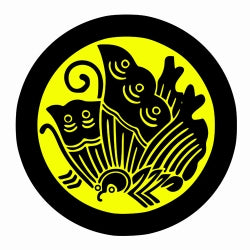Japanese Heraldry part 1

The mon was worn on three places. Traditionally, a samurai or general would not use a shield in a classical 'western' sense, instead using the large yumi (war bow), the two sword style of dai-sho (katana and wakazashi) or occasionally a two-handed dai-katana or polearm. If a shield was used, it was a large tower shield that was stood in front of the samurai and used as a defensive position whilst he fired arrows from behind it. In addition, a large mon was worn upon the back of the warrior, and the design is replicated in miniature upon each breast in front. Some samurai and generals would travel into battle with a flag attached to their backs, emblazoned with the mon. In the event that armor was not worn, the mon would be displayed in the above pattern on a ceremonial daimon, suo or kataginu.
The mon traces its roots back to the early 11th century (the late Heian period), when noble families started to adopt particular emblems to decorate their carriages and other personal items. Thus, the mon is, at its very inception, a heraldic badge. These mons were used by the courtiers and other, non-martial, aristocrats. With the ushering in of the Kamakura period, this changed. During the Gempei War (1180-85), the two factions used unadorned red and white banners to denote the opposing sides. By the 13th century, the mon was being utilized as a means of identification in battle. . By the opening of the 14th century, an army would sport over two hundred different mon-emblazoned banners. As time wore on, the Japanese analog to the knight, the Samurai, was transformed from a simple fighter to a gentleman with refined tastes and appreciation of the courtly ways. As part of that, the mon became adopted by the Samurai and their overlords, the Daimyo. It transferred a modicum of respectability and mon became synonymous with the name of the person who it belonged to. A mon was usually passed down through the generations unchanged, each member being able to be identified by their predecessors deeds.
All of this came to an end in the ‘Age of Battles’ (mid 15th century through 1600), for this time was an era of civil war and many families were torn apart by political divisions. Thus, differencing in mons was needed. In addition, mons were awarded to persons for conspicuous heroism and gallantry. This was, as can be imagined, when the most profuse proliferation of new mon designs was seen.











